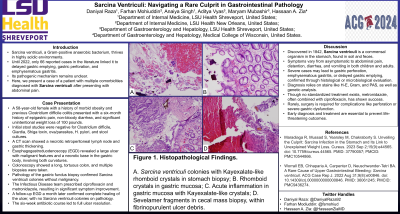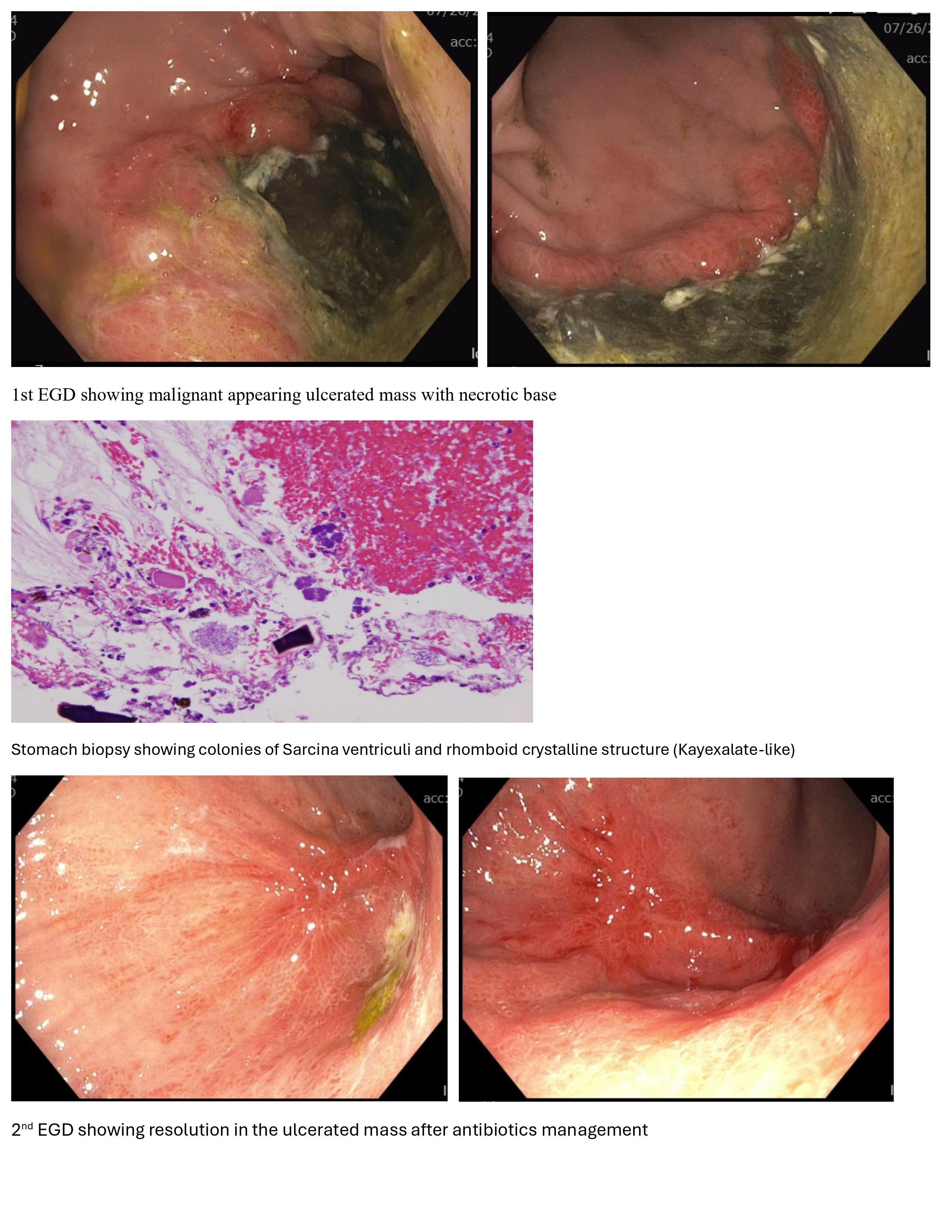Sunday Poster Session
Category: Stomach
P1663 - Sarcina Ventriculi: Navigating a Rare Culprit in Gastrointestinal Pathology
Sunday, October 27, 2024
3:30 PM - 7:00 PM ET
Location: Exhibit Hall E

Has Audio

Daniyal Raza, MD
LSU Health
Shreveport, LA
Presenting Author(s)
Daniyal Raza, MD1, Farhan Mohiuddin, MD2, Anaiya Singh, MD3, Aditya Vyas, MD4, Maryam Mubashir, MD1, Hassaan A. Zia, MD1
1LSU Health, Shreveport, LA; 2LSU Health New Orleans School of Medicine, New Orleans, LA; 3Ochsner LSU Health, Shreveport, LA; 4Louisiana State University Health, Shreveport, LA
Introduction: Sarcina ventriculi,a Gram-positive anaerobic bacterium,thrives in highly acidic environments.Until 2022,only 66 reported cases in the literature linked it to delayed gastric emptying,gastric perforation,and emphysematous gastritis.The exact pathogenic mechanism remains elusive.In this case,we describe a patient with multiple comorbidities who was presented with abdominal pain and was ultimately diagnosed with Sarcina ventriculi.
Case Description/Methods: A 58 y.o. female with PMH of morbid obesity,and a prior episode of C. diff. colitis,presented with a 6 month history of epigastric abdominal pain,non-bloody diarrhea,and a substantial unintentional weight loss of 100 lbs.Initial stool studies yielded negative results for Clostridium difficile,Giardia,Shiga toxin,ova/parasites,H. pylori,and stool cultures.A CT scan was performed, revealing a necrotic lymph node in the retroperitoneal area and gastric thickening.Subsequently, an Esophagogastroduodenoscopy (EGD) was conducted,uncovering a sizable ulcer with malignant features and a necrotic base, extending across the gastric body, involving both curvatures.During colonoscopy, a lengthy, tortuous colon was revealed, and multiple biopsies were taken.Pathological examination of the gastric fundus biopsy confirmed Sarcina ventriculi colonies without malignant cells.The ID team recommended ciprofloxacin and metronidazole, leading to notable symptom improvement.A month later, a follow-up EGD confirmed the complete healing of the gastric body ulcer, with pathology showing no Sarcina ventriculi colonies. Antibiotic treatment spanned six weeks ensuring total ulcer resolution.
Discussion: Discovered in 1842, Sarcina Ventriculi is a commensal organism in the human stomach,found in soil and feces.Cases range from asymptomatic to symptoms like abdominal pain, distention, diarrhea, and vomiting in both pediatric and adult populations. Specific endoscopic findings are lacking due to detection in asymptomatic individuals without accompanying histopathologic abnormalities.In severe cases,gastric perforation has been documented, and only histological or microbiological evaluation can confirm active infection.Sarcina has no standardized treatment,but metronidazole alone or with ciprofloxacin has shown success.Surgical management,though rare,addresses complications like gastric perforation and delayed gastric emptying.In conclusion,Sarcina Ventriculi induces varied upper GI pathology,underscoring the need for timely diagnosis and treatment to prevent complications.

Disclosures:
Daniyal Raza, MD1, Farhan Mohiuddin, MD2, Anaiya Singh, MD3, Aditya Vyas, MD4, Maryam Mubashir, MD1, Hassaan A. Zia, MD1. P1663 - Sarcina Ventriculi: Navigating a Rare Culprit in Gastrointestinal Pathology, ACG 2024 Annual Scientific Meeting Abstracts. Philadelphia, PA: American College of Gastroenterology.
1LSU Health, Shreveport, LA; 2LSU Health New Orleans School of Medicine, New Orleans, LA; 3Ochsner LSU Health, Shreveport, LA; 4Louisiana State University Health, Shreveport, LA
Introduction: Sarcina ventriculi,a Gram-positive anaerobic bacterium,thrives in highly acidic environments.Until 2022,only 66 reported cases in the literature linked it to delayed gastric emptying,gastric perforation,and emphysematous gastritis.The exact pathogenic mechanism remains elusive.In this case,we describe a patient with multiple comorbidities who was presented with abdominal pain and was ultimately diagnosed with Sarcina ventriculi.
Case Description/Methods: A 58 y.o. female with PMH of morbid obesity,and a prior episode of C. diff. colitis,presented with a 6 month history of epigastric abdominal pain,non-bloody diarrhea,and a substantial unintentional weight loss of 100 lbs.Initial stool studies yielded negative results for Clostridium difficile,Giardia,Shiga toxin,ova/parasites,H. pylori,and stool cultures.A CT scan was performed, revealing a necrotic lymph node in the retroperitoneal area and gastric thickening.Subsequently, an Esophagogastroduodenoscopy (EGD) was conducted,uncovering a sizable ulcer with malignant features and a necrotic base, extending across the gastric body, involving both curvatures.During colonoscopy, a lengthy, tortuous colon was revealed, and multiple biopsies were taken.Pathological examination of the gastric fundus biopsy confirmed Sarcina ventriculi colonies without malignant cells.The ID team recommended ciprofloxacin and metronidazole, leading to notable symptom improvement.A month later, a follow-up EGD confirmed the complete healing of the gastric body ulcer, with pathology showing no Sarcina ventriculi colonies. Antibiotic treatment spanned six weeks ensuring total ulcer resolution.
Discussion: Discovered in 1842, Sarcina Ventriculi is a commensal organism in the human stomach,found in soil and feces.Cases range from asymptomatic to symptoms like abdominal pain, distention, diarrhea, and vomiting in both pediatric and adult populations. Specific endoscopic findings are lacking due to detection in asymptomatic individuals without accompanying histopathologic abnormalities.In severe cases,gastric perforation has been documented, and only histological or microbiological evaluation can confirm active infection.Sarcina has no standardized treatment,but metronidazole alone or with ciprofloxacin has shown success.Surgical management,though rare,addresses complications like gastric perforation and delayed gastric emptying.In conclusion,Sarcina Ventriculi induces varied upper GI pathology,underscoring the need for timely diagnosis and treatment to prevent complications.

Figure: Images from endoscopy and pathology
Disclosures:
Daniyal Raza indicated no relevant financial relationships.
Farhan Mohiuddin indicated no relevant financial relationships.
Anaiya Singh indicated no relevant financial relationships.
Aditya Vyas indicated no relevant financial relationships.
Maryam Mubashir indicated no relevant financial relationships.
Hassaan A. Zia indicated no relevant financial relationships.
Daniyal Raza, MD1, Farhan Mohiuddin, MD2, Anaiya Singh, MD3, Aditya Vyas, MD4, Maryam Mubashir, MD1, Hassaan A. Zia, MD1. P1663 - Sarcina Ventriculi: Navigating a Rare Culprit in Gastrointestinal Pathology, ACG 2024 Annual Scientific Meeting Abstracts. Philadelphia, PA: American College of Gastroenterology.
